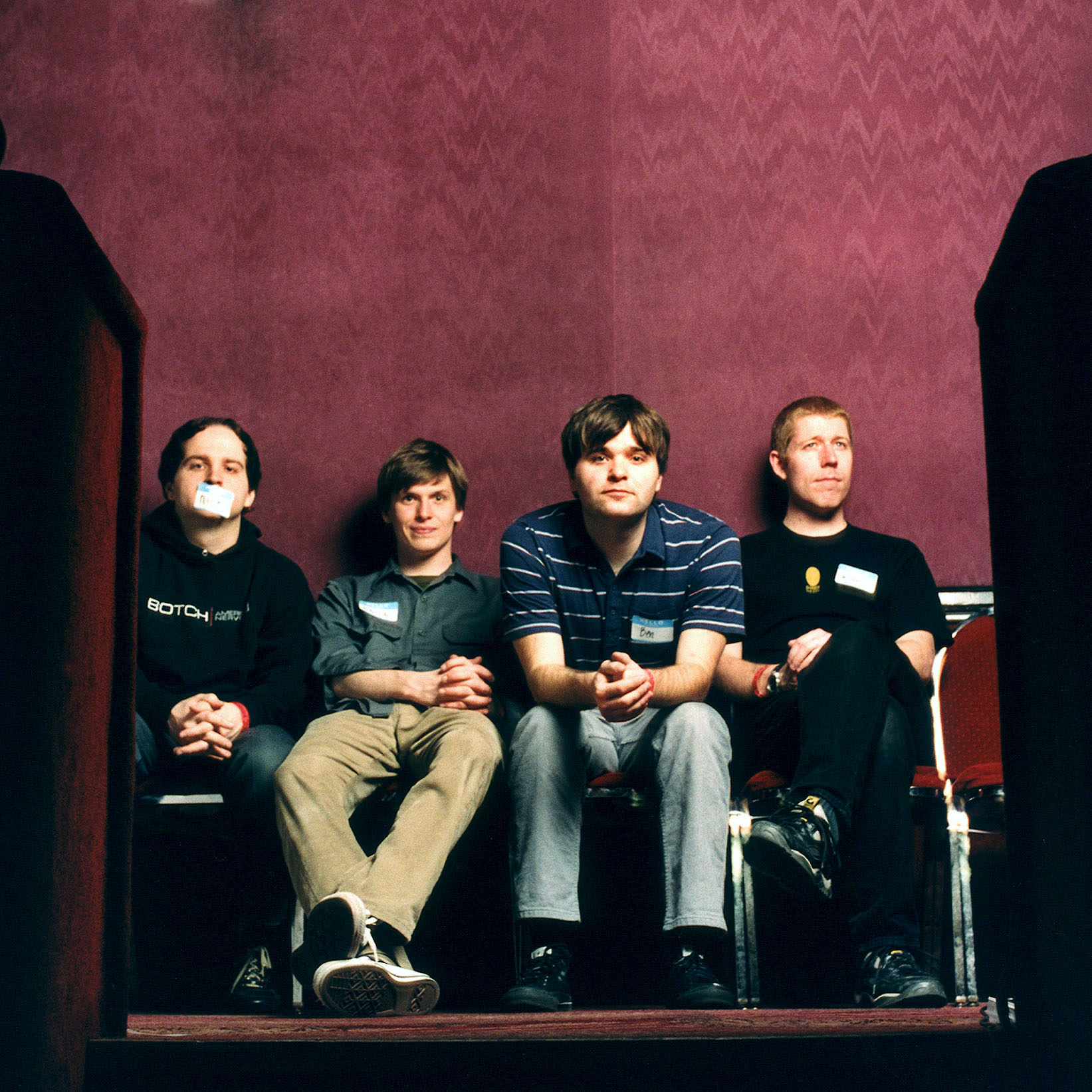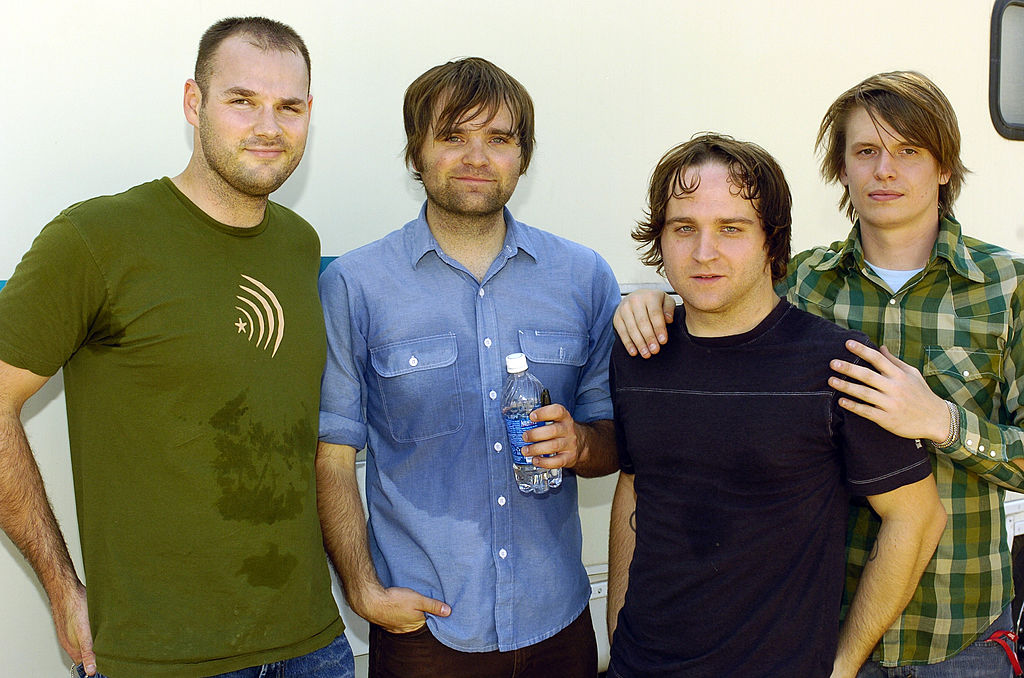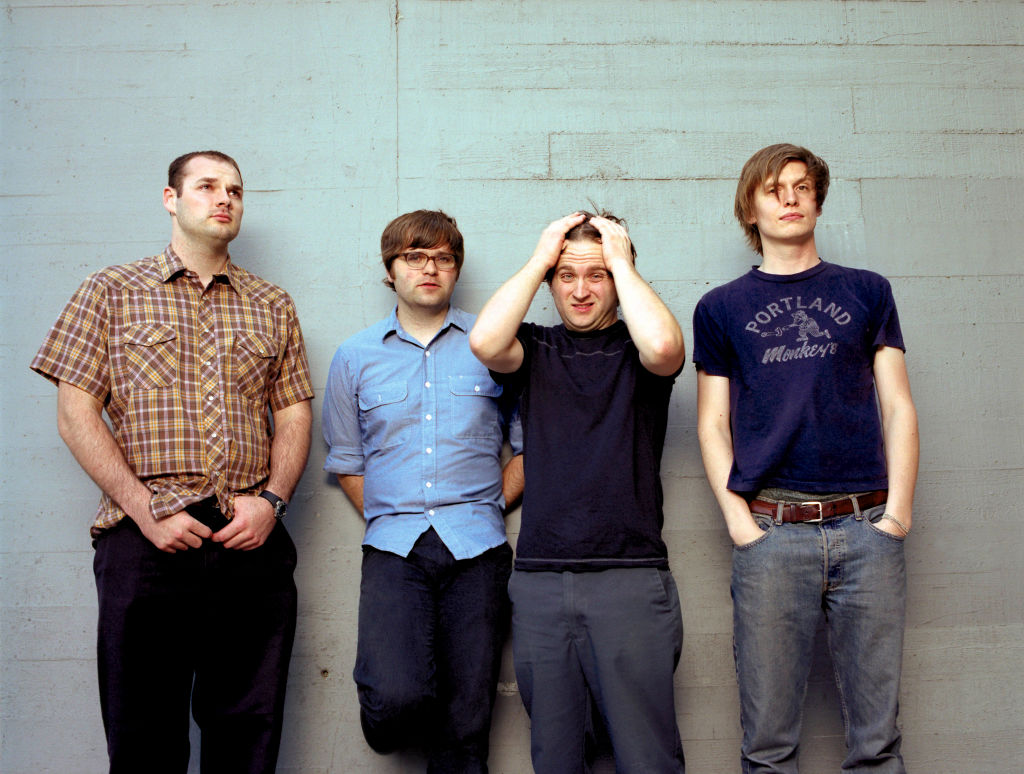“It was kind of a treacherous gamble to make,” says Death Cab for Cutie bassist Nick Harmer, reflecting on their third LP, 2001’s The Photo Album. “Making it, touring it — all of that felt really charged.”
That’s putting it mildly. After the mild indie-rock breakthrough of 2000’s We Have the Facts and We’re Voting Yes, Death Cab suddenly had to meet an array of expectations: critics, their label, a rapidly expanding fan base, even themselves.
“I was very stressed going into that record,” adds singer-songwriter Ben Gibbard. “I didn’t feel like I had enough songs. We were really burned out on each other from touring a lot. And we’d never found ourselves in a situation where we were pressured to get a record done. We Have the Facts didn’t sell super great at the time, but people definitely started taking notice of it. It’s funny I’m talking to you for SPIN, but SPIN wrote a big, glowing piece about the [2000] Forbidden Love EP. But now all the sudden we’re getting national press. It was our first foray into ‘Oh, shit, people are actually listening now. This isn’t just our friends in [Bellingham, Washington].’”
A looming deadline only amplified the tension, forcing them to record material Gibbard would have normally further refined.
“It felt a little rushed,” Harmer says. “We didn’t feel like we had the time to explore the songs as much as we normally did. But we felt like it was go time. We felt the pressure to have to record so we could get on the road and figure out the answer to this question of ‘Are we gonna be a band?'”
Given the circumstances, Death Cab haven’t always been kind to The Photo Album over the last two decades, often looking back with a slight wince more than a nostalgic glow. But time heals wounds, and 20 years prompts reissues — and the record’s newly issued anniversary package gave them an excuse to revisit the album often dismissed as “the one before Transatlanticism.”
Gibbard and Harmer spoke to SPIN about dusting off the album, covering Bjork, touring with The Dismemberment Plan, and rising above the tension that nearly derailed the band altogether.
The following conversation has been condensed and edited from two separate interviews.

It’s been 20 years since The Photo Album came out, and it’s always been a controversial album for you guys for a number of reasons. Has putting this reissue together given you a new perspective on it?
Nick Harmer: I’m able to hear it in a different way now than I have in a very long time. It was a really interesting transition for us: “Is this gonna be something we do for fun as a hobby for a while after college while we’re trying to figure out what to do next?” Or “Is this gonna be something where we push all our chips in and really make a go at it?” It was a heavy decision to make. We never thought that was a possibility to have a career, certainly not as long as we had. We were thinking in the short term: “Can we pay the rent doing this?” We were right on the cusp of “maybe we can, maybe we can’t.” And the only way we were gonna know is if we jumped.
For years, I didn’t want to listen to that because it reminded me of that tenuous time. And I don’t want to give the impression that the entire time we were at each other’s throats and fighting, but there was big tension as people were navigating a big life switch, and we needed to work some stuff out. And we did! And now I can listen and hear it in a much different way. And I’m proud of the record. I think there are some really great songs on the record, and where it sits in the progression and lineage of our band, it’s a crucial piece to get from the house where we made Something About Airplanes to even today.
It’s really interesting to check out these demos and compare them to the final shape they took on the album. “Coney Island” almost has this crunchy, country guitar tone — that one could have gone in a totally different way.
Ben Gibbard: Yeah, for sure. With varying degrees, we’ve always tried to avoid having the song do the exact thing you think it’s gonna do. If I wrote a song like “Coney Island,” it was kind of like a Neil Young stomp. In my mind, it sounded like something off After the Gold Rush. But when it gets presented to the band, it’s like, that’s not who we are. I think the band — and myself, to a certain extent — were adamant that we not lean directly into what the song was influenced by.“Coney Island” isn’t one of my favorites from a song perspective, but from a presentation perspective, it’s really indicative of the journey [from demo to finished song]. I have a four-track version where I’m playing slide-guitar, and it’s a really different vibe. But that’s a real testament to [former member/producer Chris Walla’s] creativity and how he would approach some of those songs.
Harmer: What’s always been really interesting in this band from day one: We’re all centered around a primary songwriter, Ben, who demos songs, comes up with arrangements and parts, brings them to us — and that’s kind of when the work begins in some ways. That’s when people begin to find their entry points and connections. Sometimes things don’t change very far from his original conception of the demo, and sometimes they’re radically different. When I hear the demo of that, I don’t know which version I like better. That song could have gone a lot of different ways. I can’t even begin to unpack the logic of how we got there — that’s more of a production call on Chris’ end of why it changed so much. But I listen back and go, “It’s a good song. It’s got a catchy melody.” We can debate all day long about how to present that, but a good song can be presented in a lot of ways and still hold up.
Here to promote this reissue, not disparage the songs. But Ben, you placed The Photo Album toward the bottom in a 2018 Vice feature ranking all the Death Cab albums, and you mentioned a couple songs being “really undercooked.” Which ones were you talking about?
Gibbard: It’s funny that we were talking about “Coney Island” because that’s one of the songs I was thinking about. We finished a tour in March, and I had four weeks to write however many songs to finish the record. It felt like I was just throwing shit at the wall to see if it would stick. It became the “This is good enough for now” [songwriting] approach, and that made me very nervous. I wanted to bring in things that were totally finished, with sound structures, and not like, “Does this need another part?”
I wouldn’t be talking to you right now if I didn’t have some love for The Photo Album. I don’t want to give anyone the impression this is a record I dislike. It’s more that the experience of making it really colored my feelings about it. That’s unfair for the listener — at the time we really didn’t talk about it much, but it was arguably the most difficult period in this band’s history. We almost broke up a couple times. We had to really recommit to the idea of what this was and what we wanted to accomplish.

“We Laugh Indoors” is a top-five all-time Death Cab song for me. It’s so hypnotic. It has some incredible imagery — the construction noise and gutter punks — but it all hinges on that chorus of “I loved you, Guinevere.”
Gibbard: To me, that song lyrically is kind of like a bridge between an obtuse style that I wrote with [early on] into using more direct language, which I started doing on Transatlancism. “Company Calls” is a perfect example of that — it’s impressionistic, and maybe it’s coming from of my love of early R.E.M., where you can just string words together that are related but very open to interpretation. It’s not as if I planned this at the time, but because we played the songs live, the verses are very impressionistic, and then it lands on this very direct line that just gets repeated over and over again. “I love you “ — it’s one of the more direct things you can say.
I still love playing it, but at the time, it was such an outlier of everything we were playing. It was one of three or four songs we started playing live before the record came out, and it seemed like people were really reacting to it because it was so different for us. But I recognized very quickly when we recorded it, that’s the exact beat from “Don’t Lose That Number,” that Phil Collins song. Every once in a while when we played it live, we’d kinda break into it — I’d hear Chris go [hums guitar riff] as kind of an in-joke.
Harmer: That was a song I think found itself because we were able to tour it and really find the muscle and edginess in it. I think [Chris’ and my] contributions to the structure of that song came from just being able to play it live and work out that rock section where it opens up and gets kinda trashy for a second.
I remember Chris pushing Ben at the time to allow himself to get kind of emotionally aggressive, as much as Ben can, in that big section. For better or worse, we’re very much a band that’s squared around the edges. We play and keep things kind of contained and neat and symmetrical, and we’re diligent about each choice we make. There aren’t a lot of moments where we just let ourselves get messy and not get so concerned about following melodic structure. There are a lot of half-step movements in that section that are kind of melodic compared to a normal chorus section for us. That was just a time for us to smear the paint. It worked really well live, and you could feel the release in the room. That just emboldened us to keep that when we made it in the studio.
“Why You’d Want to Live Here” is another one you played live beforehand. Pretty scathing track.
Gibbard: I think we’d only played in L.A. a couple times. If you’ve ever driven down I-5 into Los Angeles, it opens up into this endless expanse of light, especially at night. It just seemed so big. Coming from the Northwest, Seattle is technically a big city, but if you go 20-30 miles in any direction, you’re in the mountains. I think I was very intimidated by [L.A.] Now, in the last 10-15 years, L.A. has become a destination for independently minded, creative people — in a way it definitely wasn’t in the ‘90s. Any band who moved from Seattle to L.A., it was like, “What are you fucking doing?” It wasn’t what it is now. There weren’t a breath of indie labels. The scene down there is more healthy than its ever been, but it wasn’t like that in the ‘90s. It was still people going down there to get record deals. The independent scene was much smaller, much less pronounced — it was all in Silver Lake basically.
It was large and intimidating, and I just decided to drag it for four minutes. [Laughs.] But at the end of the day, the song is really about someone who’s very insecure about someone they love moving to Los Angeles or having just moved there. In my mind, the character is traveling around Los Angeles with someone who just moved there, going, “Really, you like this?” And the reality is that they’re upset that they lost somebody to this monolithic city.
A lot of fans probably still assume “Styrofoam Plates” is autobiographical, even though I understand you wrote that based on stories a friend told you. What a heartbreaking song.
Gibbard: One can argue, and I would, that the definition of one’s life experience expands past things that have just happened to you. A good friend of ours who was our first real road crew person, he’d had a tumultuous relationship with his father, who passed away, and I went up to the funeral to pay my respects, and I was really moved by everybody’s attempts to kind of frame this person as a good person. He’d done a lot of terrible things. I drove back to Bellingham from Seattle with a note pad on the passenger seat, and — I probably shouldn’t have been doing this — but I was just writing the song as I was driving. I had the melody, and I wrote the entire thing on the drive back to Seattle in 90 minutes or whatever. This was a life experience I had vicariously through my friend who told me all about this. I of course had his blessing — it wasn’t like I’d stolen his story. At least he didn’t see it that way. It was a story I felt needed to be told.
I find sometimes, certainly back then, that people felt I was some kind of depressive or very unstable or always sad. Years ago I remember doing a piece for some publication, and the journalist afterward referred to some period of our records where I was “really sad,” and now I was happy on this new record. That’s never how it works. As a songwriter, I’m sitting alone in a room with an instrument, and it’s a very similar headspace you get to when you’re can’t sleep and looking at the ceiling and all your darkest, most doubtful thoughts — all those voices in your head that you suppress all day — they come out. And they talk to you. And that’s a lot of what my songwriting has been.
It’s fascinating to me that you’re able to cover “All Is Full of Love” — which is so classically Bjork in every way — and make it sound classically Death Cab.
Gibbard: The version that’s on the Bjork album didn’t really do much for me. But there was a remix that got used with a Chris Cunningham video, this absolutely stunning video — it’s so beautiful. I remember seeing that and being like, “This is amazing.” The chords, the harmonic information, was so similar, I thought, to the kind of thing I’d write. I’m in no way insinuating that anyone stole anything from me. But I brought it to the band and was like, “Should we do this?” Michael [Schorr] had this breakbeat thing, so the band is playing halftime, and Michael is playing double-time. It just clicked. We were playing it a lot in that era. What can you say about Bjork that hasn’t already been said? She’s one of our generation’s true geniuses.
Did you ever talk to her about your cover?
Gibbard: I’ve never met her — I think she lives on Saturn. [Laughs.] I tend to not rub shoulders with people from Saturn. Maybe she’s aware of it, maybe not.
What do you remember about touring with the Dismemberment Plan on the Death and Dismemberment Tour? For one, it’s probably the greatest tour title ever.
Gibbard: It was like the second national tour on that record. The Dismemberment Plan were touring on Change, I believe. I think it was Travis Morrison who came up with that name. Maybe it was Walla. We had met them in ’99/2000, and we just became fast friends. I remember when Emergency and I came out, I wasn’t familiar with them until that record. That record really started hitting, and I was so enamored with Travis as a writer, and their arrangements are so interesting. I felt like we found true kindred spirits.
The Dismemberment Plan were road dogs like we were. They didn’t have jobs. We became friends, and they’d come see us in D.C., and we’d go see them in Seattle. We hooked up for this tour. I’m so glad you asked about this. This era was such a magical time in our band — our bands were about the exact same size, playing some slightly bigger venues, but we were just caravanning around the country in two vans. I have so many wonderful memories. We had a Motel 6 book on the dash of the van, and we’d come back to the hotel and have a couple beers or a glass of whiskey and just goof off, hop in each other’s vans for different drives. It was the kind of tour and camaraderie I always dreamed about when before I was even in a band. It was the kind of experience I wanted to have on the road with other bands — that we were all in this together.
None of us had any allusions that it could ever get any bigger. There wasn’t any ego. There weren’t people from major labels coming to the shows, trying to take us out to dinner. From 2001 to early 2002, we were living high on the hog. We were never gonna get any bigger than that. As big as we were at the point, it was so much larger than I ever fathomed we could have been. The idea of being part of the music industry was so far outside of the purview of anything we were doing at that point. It felt like, between us and the Dismemberment Plan, that we’d really built this fanbase ourselves. Not that there’s anything wrong with us, but we weren’t the recipient of a license on a very popular TV show on Fox. [Laughs.] We hadn’t been name-checked by Natalie Portman in a movie or something like that. This music we were playing was still very much underground, but it had a very rabid fanbase. There was nothing getting between us and the people who enjoyed our music. There was no rock star bullshit. It was just: “Take it at face value. This is us. This is what we do.” It was one of my top three periods — maybe even my favorite period — of the band.
Harmer: I don’t like using hyperbole like it’s my “most favorite” — but it is a tour that I often revisit in my mind and my heart. I loved touring with those guys, forging such an amazing friendship. It was so inspiring watching them play their music every night. We learned a lot about being a band at a crucial point in our development, seeing them be a band — seeing how they operated, what their dynamics were. We felt like there was some real possibility, like the gamble was starting to pay off, like, “Oh, my gosh, we might be able to do this for a little longer.” It’s a lifelong moment. I’ll carry that with me forever.





